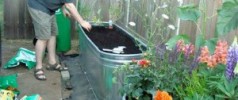You buy all the seeds and small plants for your vegetable garden. You spend time day dreaming about the day you will pick all the fresh vegetables. But, what you didn’t think about is your soil. Maybe you did, because you’re still having problems that don’t involve garden pests. The problem could be your soil.
Know the signs of bad soil, and what can cause it, before planting your garden.
Here are 10 indications of bad soil and how to fix the problem.
- Low Nitrogen: If your plant leaves (low on the plant itself) are discoloring and falling off the soil is likely low in Nitrogen. Adding compost to the soil is an organic way to fix this issue.
- Low Phosphorous: Do your plants look purple? They are likely low in phosphorous. This happens because of the temperature of the soil. The Phosphorous is probably there but because of the temperature of the soil it’s unable to be released to aid the plant. Use some mulch to increase the soil temperature and get the phosphorous to release.
- Too much Nitrogen: Do you have lush foliage but little to no fruit? You could have too much nitrogen. Other signs include wilting and downward cupping of older leaves, followed by yellow and brown burnt areas on lower leaves. How do you fix this problem? Oddly enough – mulch will fix this. Go slowly. You can also plant vegetables that will deplete or bring down the levels of nitrogen like cabbage, broccoli and corn.
- Pollination: Even vegetables need pollination in order to bear fruit. If your plant is blooming but not producing you could need more birds and bees. Plant some flowers around the border of your garden. While you’re waiting you may have to cross-pollinate yourself. I don’t know if dinner and a movie will help but who knows.
- Uninvited guest to your garden: If you’re making a hanging floral wreath moss is great. Moss is not so great in your garden. Moss means your soil high in acidity. Add some wood ash or lime to bring your soil to a more neutral level. Also at the end of the planting season take a good look at where your garden is located. Moss hates direct sunlight. If you have overhanging tree branches or bushes that block the sun from your garden, moss will, and can grow. Get rid of any sunlight obstruction.
- Volunteers: A plant that grows on its own rather than be deliberately planted by a farmer or gardner. For example have you ever seen a corn plant in the middle of a soybean field? That corn plant is a volunteer. A hold over from last years corn crop. No matter how large or small the garden volunteers can happen. Why are volunteers bad? There bad because you should rotate your crop every year to avoid disease. Seeds can be brought to your garden by a good wind, or a bird flying over. The best way to deal with volunteers is to pull them as soon as you see them coming up.
- Clubroot: Clubroot affects cabbage, radishes, turnips all plants of the Brassicaceae family. Clubroot lives in the soil and does horrible things to the roots of plants. The roots look knobby and swollen upon examination. It doesn’t just affect the roots it also caused under-developed vegetables and eventually the death of the plant. The women of my family always told me the roots look like the hands of someone with arthritis. If you suspect or have confirmed this is the problem you may as well not plant anything susceptible to clubroot for at least 7 years.
- Water: Puddles of water, or standing water, are very bad for your garden. If you live in a climate with lots of rain you understand the dilemma. Often times gardeners who are eager to get their gardens started in the spring deal with this issue. How do you know when your soil is ready after the spring thaw? Take a handful and squeeze. If water drips from your hand then you need to aerate the soil.
- The crumble: Is your soil crumbly like a good coffee cake or dry, hard and cracked? The soil should be crumbly. If it’s dry and cracked, water will run off and not absorb into the soil like it should. Also, not enough water will make it to the root system and allow the roots to grow down in all that hard soil. So, crumbly good. Dry and cracked bad. How do you deal with this problem? Add organic matter and add it often. Also, do not compact the soil.
- Test your soil. The best piece of advice I can give is to have your soil tested or do it yourself. Some nurseries and garden centers will test your soil samples or you can buy a kit and do it yourself.
 10 Ideas for a Raised Vegetable Garden Bed
10 Ideas for a Raised Vegetable Garden Bed
[…] See more at Backyard Growers […]